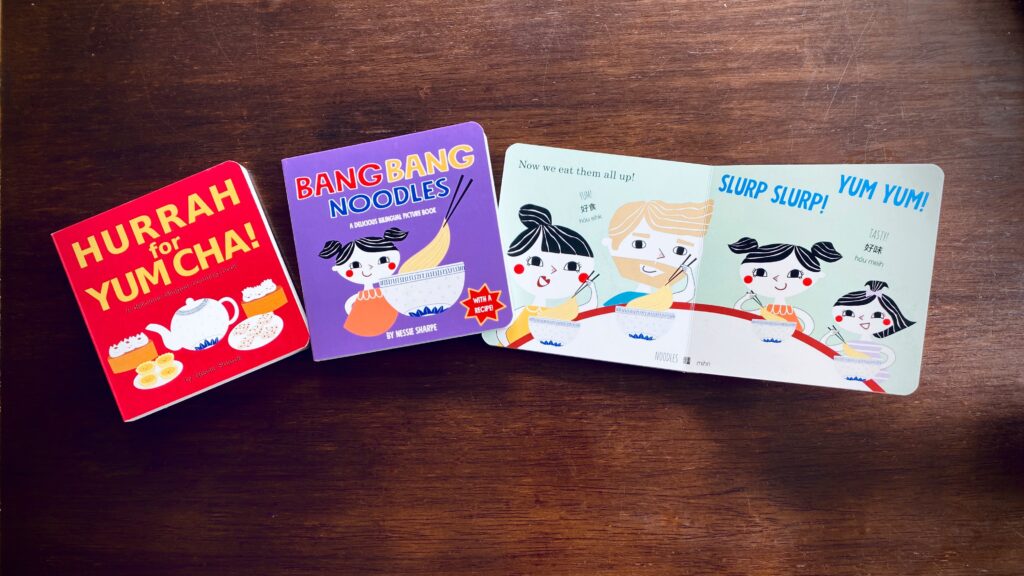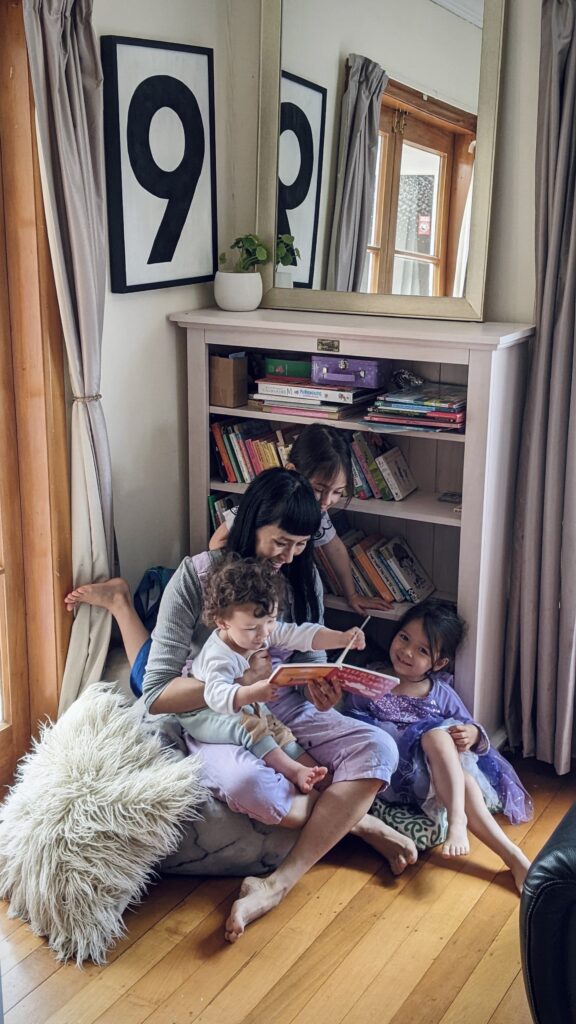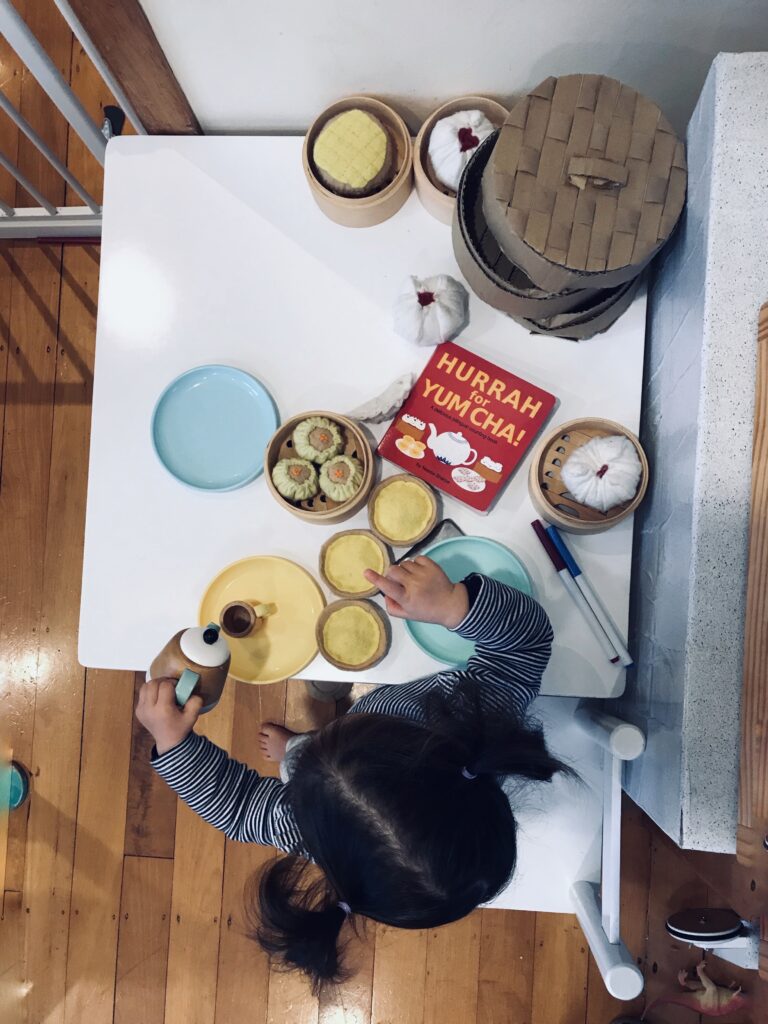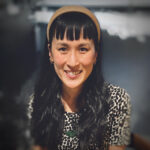Chinese-Kiwi author and illustrator Nessie Sharpe struggled to find bilingual picture books that represented mixed-culture families like hers—so she wrote her own.

I was watching the kids playing tea parties one rainy afternoon.
They were serving each other wooden cupcakes on pastel-coloured plates and pouring imaginary tea from a little teapot into tiny tea cups. It was an utterly adorable scene but as I watched, I found myself wistfully wondering, How fun would it be if they could play yum cha tea parties instead?
Our family is a mixed-culture Kiwi-Asian family. My husband is New Zealand European and I am Hong Kong Chinese, having moved to New Zealand as a young child in the 80s. My childhood was a wonderful blend of both Kiwi and Chinese culture. I played bullrush at lunchtime and ate mince and cheese pies from the tuck shop but also went to yum cha on the weekends and had rice for dinner every night. We ate mooncakes at Mid Autumn Festival, and Christmas mince pies and pavlova at Christmas time.
I wanted my kids to grow up proud of their Chinese and Kiwi heritage and their third culture, their unique blended experience of being Chinese-Kiwi
When I was younger it was important to fit in and be as Kiwi as possible. Little by little I lost the ability to read and write Chinese. When I moved out of home, even my spoken Cantonese began to fade. However, having children became a catalyst for me to embrace my Chinese side again. I went on a journey of reclaiming my Chinese heritage and Cantonese language. I wanted my kids to grow up proud of their Chinese and Kiwi heritage and their third culture, their unique blended experience of being Chinese-Kiwi.
We made the decision to follow the “one person one language” technique with the kids. I would speak exclusively in Cantonese to the children, despite my husband and I speaking to each other in English. This forced me to speak more Cantonese than I had for years. Cartoons were surprisingly helpful—I owe a lot of my language improvement to Cantonese Peppa Pig. When it came to reading books to the kids, I transliterated English picture books into vernacular Cantonese on the fly as best as I could. We try to celebrate all the major Chinese festivals by picking out the fun and delicious parts to get the kids excited about Chinese culture. We wanted to harmoniously weave together their Kiwi and Chinese sides into everyday life.
Which is why the idea of yum cha tea parties appealed so much. Everyone loves yum cha. It’s delicious. There’s theatre to it: the servers weaving between tables, pushing trolleys stacked with bamboo steamers; the petite perfectly formed dim sum dishes; the clinking of tea cups and chopsticks. What a fun and relatable way to both incorporate Chinese culture into play and learn yum cha-related phrases in Cantonese.

I became a little obsessed with the idea. When I couldn’t easily buy yum cha-themed toys, I set about hand-sewing yum cha toys myself. Since the kids were also showing an interest in counting and reading, I went on a mission to find yum cha-themed books and more generally bilingual books celebrating Asian culture but found the choice of bilingual books to be very limited.
There were books with English stories directly translated into Chinese characters aimed at those fluent in reading Chinese. These weren’t right for us as I could not confidently read Chinese anymore. There were non-fiction picture books written in English pitched at educating about Chinese culture in general. These were not quite right either. There were also books with stories revolving around an Asian character as a new immigrant with limited English trying to fit in. These also did not reflect our family.
I was searching for books that normalised Asian culture in a way that mixed-culture families like ours would relate to. Options for parents like us, who aren’t aiming for full fluency but a more modest able-to-recognise-menu-items level of proficiency, were practically non-existent.
I was searching for books that normalised Asian culture in a way that mixed-culture families like ours would relate to
It was also important to me that the books included Cantonese. Most bilingual English/Chinese books use Simplified Chinese characters and Mandarin pronunciation. My family language is Cantonese, which has different pronunciation than Mandarin and uses Traditional Chinese characters. Cantonese is the most commonly spoken form of Chinese after Mandarin in the world, with over 80 million native speakers worldwide.
Cantonese also has special significance to New Zealand. Chinese New Zealanders have been a part of the Aotearoa story since the 1850s, when Chinese gold miners were invited to move to Otago during the gold rush. The miners who arrived were from the Guangzhou region, previously known as Canton, and they brought with them the Cantonese language, food, and culture. Many New Zealand Chinese families who originally settled here during the gold rush consider Cantonese to be their family language too. It is the seventh-most commonly spoken language in New Zealand, with 52,767 speakers according to the 2018 census, and was the most widely spoken Chinese language in New Zealand up until 2018 when it was overtaken by Mandarin.
It is important for children to see themselves in books of all kinds and for all kids to see that role models and stories come in many different shapes, sizes, and colours
The more I researched and talked to friends and family, the more passionate I became about finding books that reflected Kiwi-Asian families. Historically children’s literature has been predominantly monocultural. Most picture books reflect the images and narratives of the dominant culture. It is only recently that there has been a push for better diversity, inclusion, and representation in kids’ books. It is important for children to see themselves in books of all kinds and for all kids to see that role models and stories come in many different shapes, sizes, and colours.

By the time New Zealand went into lockdown in 2020, I had convinced myself that it would be a great idea to create these books for our family to read, and as presents for friends and whānau. Food has such a powerful connection to culture, family, tradition, and heritage that it was obvious to start with a food-themed book, and—since yum cha is arguably the most famous Cantonese meal—a yum cha-themed book. I wrote and illustrated Hurrah for Yum Cha! to teach my kids how to count to ten in Cantonese and English with the help of dim sum dishes. Also Bang Bang Noodles, which celebrates making hand-pulled noodles—a frequent meal in our household—using our own mixed-culture family in the illustrations. The few copies printed off as presents received such overwhelmingly positive feedback that I set about publishing them properly.
It is a dream of mine to see more books that explore Kiwi-Asian stories, food, and culture in New Zealand’s children’s literature
I have been absolutely blown away by the response. New Zealand Chinese families love having books that are accessible and relatable, and stories that they could see themselves represented in. Families of all backgrounds enjoy reading about their favourite Chinese foods—even taking their copies out to yum cha with them! It has been incredibly rewarding getting to connect with these families who share our cultural journey and our love of Chinese food.
It is a dream of mine to see more books that explore Kiwi-Asian stories, food, and culture in New Zealand’s children’s literature. Inclusivity in the books we read to kids encourages appreciation, respect, and celebration of different backgrounds and perspectives. Not only do Kiwi-Asian kids deserve books with characters that look like them and books that tell their stories, but all kiwi kids deserve books that reflect the rich tapestry of our thriving multicultural community in Aotearoa New Zealand.
You can purchase Nessie’s books directly from her website, https://coprosmabooks.wixsite.com/home
Editors’ note: The Reckoning is a regular column where children’s literature experts air their thoughts, views and grievances. They’re not necessarily the views of the editors or our readers. We would love to hear your response to any of The Reckonings – join in the discussion over on Facebook.

Nessie Sharpe
Nessie Sharpe is a Kiwi-Chinese author illustrator living in Tāmaki Makaurau with her husband and three young children. She is also a medical doctor, policy analyst, and ex-corporate lawyer. Nessie is passionate about multiculturalism in children’s books and has published two picture books, Hurrah for Yum Cha! and Bang Bang Noodles.



